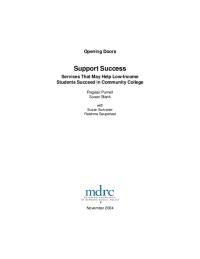Support Success
Services That May Help Low-Income Students Succeed in Community College
This paper examines how U.S. community colleges can and do organize the diverse set of guidance, counseling, and other supports — collectively known as student services — that surround their academic programming. To many Americans, community colleges are the most accessible way to earn the postsecondary degrees that can be stepping stones to economic and personal success. In addition to typically charging lower tuitions and using less stringent admissions policies than four-year colleges and universities, community colleges are often better geared to the needs of students who have low incomes and to so-called nontraditional students, such as young single parents, financially independent adults, welfare recipients, students of color and of immigrant backgrounds, first-generation college students, and older and disabled students. However, many of these students never graduate from community colleges. To address the problem of high attrition rates in these institutions, MDRC has launched a demonstration called “Opening Doors,” which provides for one of the nation's first large-scale experimental evaluations of innovative strategies to help community college students complete their degree programs. Besides curricular and instructional reforms and supplemental financial aid, the third broad strategy being tested in the demonstration is the enhancement of student services.
Drawing on a literature review, reconnaissance work to develop Opening Doors, and information on early operations of the community college sites in the demonstration, this paper provides an overview of the current state of student services and promising practices for service delivery. It examines five interrelated but distinct elements of a student services program: academic guidance and counseling; academic supports (direct instruction and tutoring on academic subjects and skills); personal guidance and counseling; career counseling; and supplemental supports like child care, transportation help, and book and supply vouchers. In addition, it considers two strategies for providing student services that cut across these categories: (1) programs targeted to low-income and nontraditional students that offer combinations of different kinds of counseling and supports and (2) multiservice centers. For each element of student services, the paper highlights innovative practices found at community colleges around the country. A concluding section offers observations on needs and opportunities associated with the provision of student services in community college settings.






